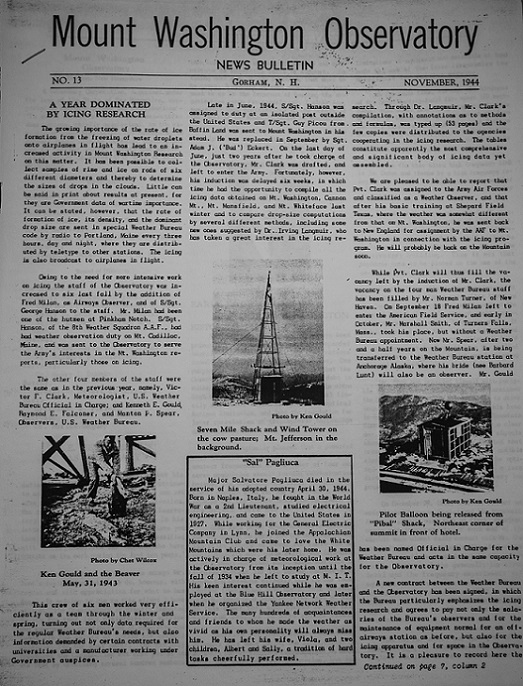Instrumentation by the Decade
2019-06-07 15:38:09.000 – Charlie Peachey, IT Intern


Research on rime icing kicked into high gear with the onset of WWII. Their research became even more important because it now was being used to better prepare planes for icing conditions during the war. Fred Milan and Staff Sargent George Hanson were added to the Observatory staff in order to better fill the need for more intensive work. Staff Sargent Hanson was sent to the observatory to represent the Army’s interest in the reports specifically concerning rime icing. Additional staff wasn’t the only addition to the observatory spurred on by the riming research. Renovations to the observatory took place to build a tower for the weather instrumentation to sit on, so it could better record the conditions on the summit.

After several years of research on riming, it grew apparent that the meteorological instruments needed to change too. Specifically, the originally heated anemometer and its predecessor the cup anemometer. Both of these instruments proved to be useless in icing conditions, so a new instrument was needed. In 1945, Adam J. Eckert began working on reconfiguring a pitot-static tube meant for airplanes into a weather instrument meant to face some of the worst weather in the world. With the much needed assistance and encouragement of Vincent Schaefer (who worked for General Electric at the time), the first pitot anemometer was built and in operation on April 1st, 1946. It looked a lot like instruments today, but with a lot less power. It used a total of 350 watts to run where today’s prototype General Electric pitot tube uses about 3,800 watts of electricity to remain ice free during the harshest Mount Washington weather . Pictured below is the first weather report using pitot tube data for its observations and the front page of the Mount Washington News Bulletin from November 1944.


Information from this post has been sourced from Mount Washington Observatory: The first 45 years, 1932-1977
I am excited to show more Mount Washington history over these next few weeks of my internship with the IT department. I spent hours digging through the Mount Washington archives to find some of the original documentation and instrumentation of the 1940’s! All the photos in this post were taken and edited by myself.
Charlie Peachey, IT Intern
Team Flags Return for Seek the Peak’s 25th Anniversary
Team Flags Return for Seek the Peak's 25th Anniversary By MWOBS Staff Mount Washington Observatory is looking forward to continuing a much-loved tradition for Seek the Peak’s 25th Anniversary: Team flags. In inviting teams
Meet Summer Interns Zakiya, Max and Maddie
Meet Summer Interns Zakiya, Max and Maddie By MWOBS Staff We are excited to welcome six teammates to the summit of Mount Washington this summer! During their internship, these students and graduates will play
Saying Goodbye to the Summit
Saying Goodbye to the Summit By Alexis George After an extraordinary last three years working as a Weather Observer and Meteorologist, I am excited to pursue a different career. As sad I as am




